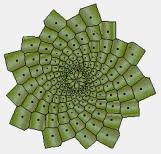

To
learn how to construct spirals using polar graph paper
To
investigate spiral pattern formation in plant growth (Phyllotaxis)
To
create a realistic model of a pattern of parastichies spirals using drawings
(and later clay models)
Connection Previous topics:
Fibonacci
numbers
Golden ratio
Golden Spiral
Materials:
Paper, scissors, protractor, ruler, sheets of concentric circles or polar graph
paper
Activities:
1.
Using the sheet of concentric circle generate a spiral by placing one dot
on each circle starting from the inner circle and moving outward circle by
circle. Consider what geometric rule you might follow in placing your dots so
that the spiral you generate is regular. When you have finished connected the
dots in the order.
There are several ways to generate spirals. One way is to place the dots so that the angle between dots on adjacent circles (as measured from the center of the circle) is constant. This angle is called the divergence angle. When the divergence angle is small the generating spiral is easy to see visually. When larger divergence angles are used, the generating spiral is not as evident, however, often other spirals will emerge as your eyes make connection between nearest neighbor dots. These spirals are called parastichies and they will be investigated in the next activity
2. Different wedge shaped pieces of card with a variety of angles have been made which can be used to generate spirals with specific divergence angles. Choose one of the wedges (or create your own) and place dots on the circles as described above. Do not connect the dots in the order you placed them, but instead look for the most obvious visual spirals that emerge (the parastichies). Connect the dots that form these spirals. State a “connect the dot rule” that creates these spirals.
3.
Compare your pattern with the patterns that other people in the class
have created and observe the different features of these patterns. Answer the
following questions
4.
Create a spiral pattern using the divergence angle that is most efficient
for packing. The dots can represent seeds, petals, leaves, or some other plant
structure. Replace the dots in your diagram with some representation of a plant
structure of your choice. Consider altering the size and shape of your structure
as you move radially outward to make your spiral more realistic.
Preliminary Activities:
Follow-up Activities: